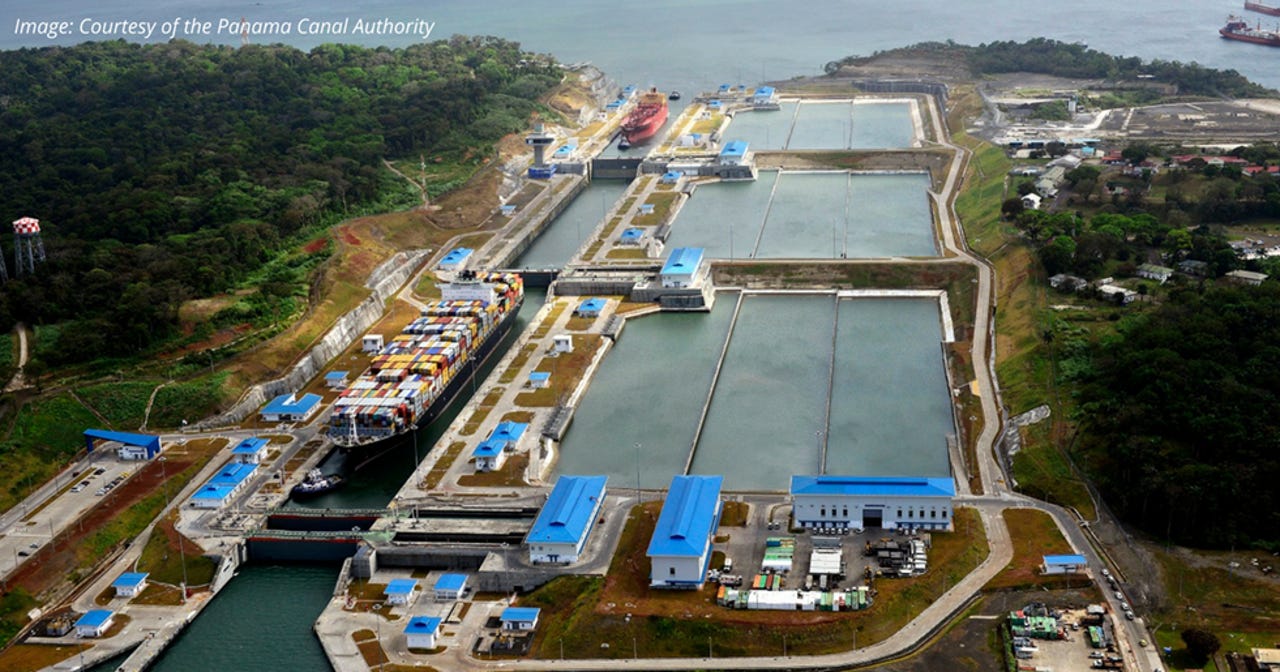How IoT is keeping Panama Canal shipping flowing just in time


The Panama Canal's new system should shorten vessel waiting times and increase the potential number of vessel slots.
The Panama Canal sits between North and South America, enabling thousands of tons of shipping to avoid a detour around Cape Horn.
Like the rest of the world, the canal relies on computer systems to keep it operating efficiently 24 hours a day, and those systems are undergoing a major overhaul that aims not only to keep them up to date, but also to help the Canal handle more traffic.
Quintiq, a subsidiary of Dassault Systems, which also has systems working at the Federal Aviation Administration (FAA), the International Space Station, and the UK's Ministry of Defence, is the company handling the upgrade.
According to Quintiq, the new system means that, for the first time, the canal will be able to execute an entirely integrated operating plan for all its critical resources.
"Improved situational awareness and data can inform better decision-making, which in turn will help mitigate operational risk," the company said in a statement. "Quintiq will also help reduce costs by optimising the way in which the Canal plans and programs its resources."
The Quintiq system should shorten vessel waiting times, increase the number of potentially available vessel slots each day, and improve the overall reliability of the route, the company said.
"We provide a single software solution that can deal with any kind of planning and optimisation challenge within a supply chain," Quintiq's head of Latin America, Camilo Gaviria, told ZDNet.
"One of the big benefits of our software is its flexibility," he added. "We can solve anything from the Panama Canal, and the vessels transiting it, and production planning, all the way through to planning the rosters of FAA controllers," he said.
Quintiq had been working with the canal for "about 18 months" when the first RFPs for planning, scheduling, and resourcing were put in.
"They were looking for a way to plan their vessels, taking into account all kinds of resources and restrictions such as maintaining the efficiencies of their transits while keeping current resources at maximum efficiency," said Gaviria.
"What they wanted was an application that could not only help the transits operate as efficiently as possible, but could also plan the way they used the boarding resources -- the line handlers, tug boats, lock keys -- on both a day-to-day operation basis and in higher levels of planning."
When the aim is to move the maximum number of vessels through the canal continuously, the scheduling is not only highly complex on a continuous basis, but there's also the issue of the weather. The weather in Panama is consistently hot throughout the year, but is also subject to sudden, sometime violent, storms in the rainy season. Another hazard is fog.
"The system gives us a better way of dealing with fog events," said Gaviria. "At different, unpredictable times of the day there can be significant amounts of fog. Using the system, we can know when fog is about to come and we can then reincorporate that information back into the scheduling system.
"We could delay a vessel because we can see the fog event coming and make a smaller vessel available."
Using the system, they could incorporate that information along with information from other meteorological stations, he said. The system can also attends to other technicalities like making sure there are enough teams to man the locks for the type of vessel going through at a given time.
Enterprise Software
"The system also makes sure that the right pilots are available along with the appropriate tug boats for the right vessels," Gaviria said.
"The system gives us a detailed plan of what is scheduled to happen over the coming 48 hours, but it also generates multiple scenarios, makes assumptions and reacts appropriately for all eventualities."
The new system, which is still being fully implemented, could also take advantage of the Internet of Things (IoT).
"There are many sensors around the canal collecting an enormous amount of data," said Gaviria. "We want to leverage that data. We think it should be easy to incorporate information such as the waiting time at the locks and locking times -- the time it takes to fill a lock," he said.
Another the way the IoT can be useful is in managing those lockage times. "Different locks fill at different rates and the previous system had different lockage times for different locks," Gaviria points out.
"Now a particular lock can fill at a particular rate, but the water pressure is often variable, so the fill rate may change over time. Now, bearing in mind that the canal is doing around 60 lockages a day, per lock, a slight difference could add 120 minutes to the time. Thanks to the IoT we can now take those variables into account."
These efficiencies over time mean the number of vessels transiting the canal has increased. It is all part of the overall plan, which is to operate the canal on a just-in-time basis.
Read more on IoT
- Trainline moves to the cloud to innovate in the transportation space
- ZTE removed from trade blacklist by US Department of Commerce
- IoT standards cannot be left to the market: US Department of Commerce
- Samsung pledges $1.2 billion for Internet of Things research in US (CNET)
- Why IBM's speech recognition breakthrough matters for AI and IoT (TechRepublic)